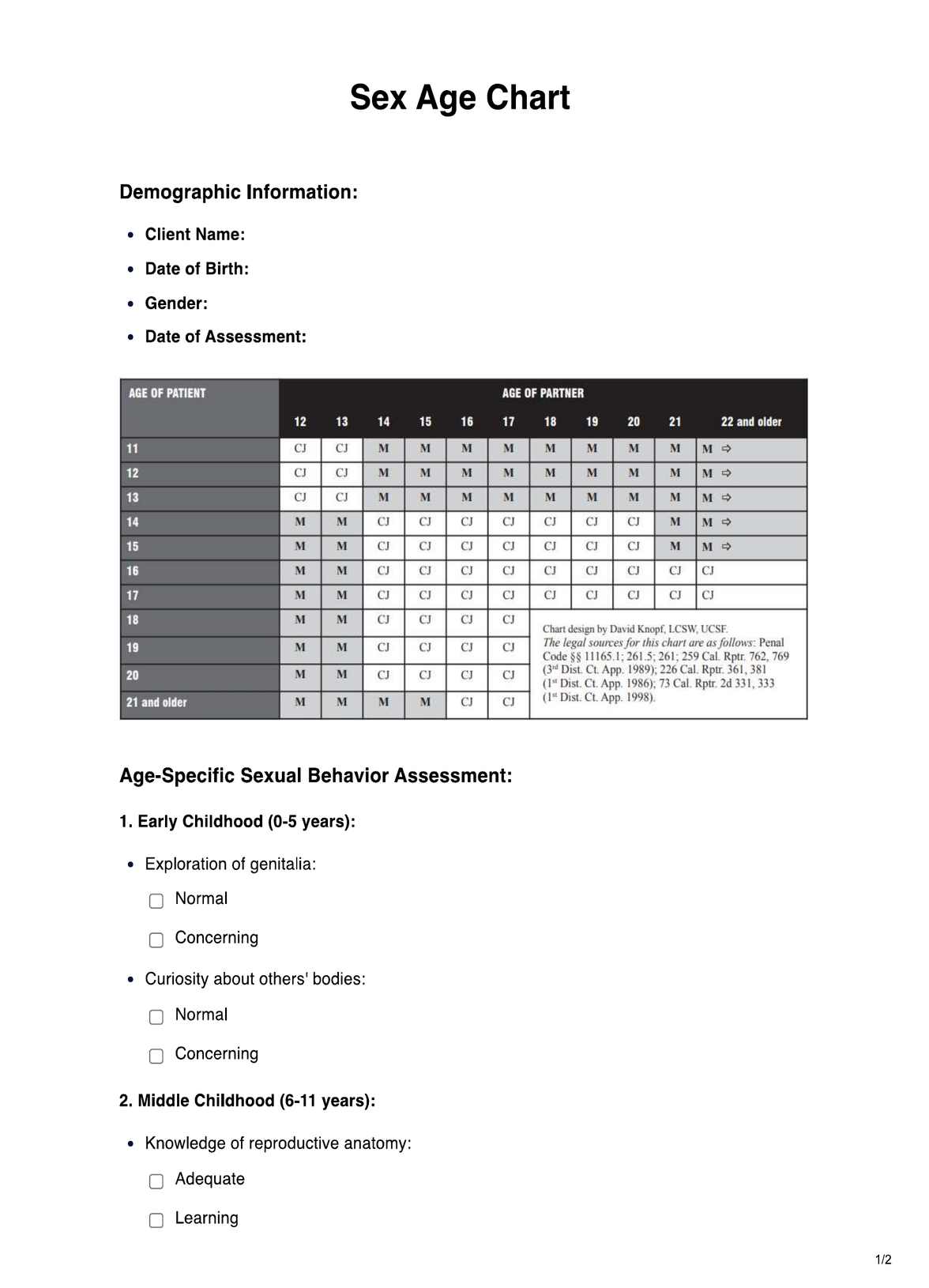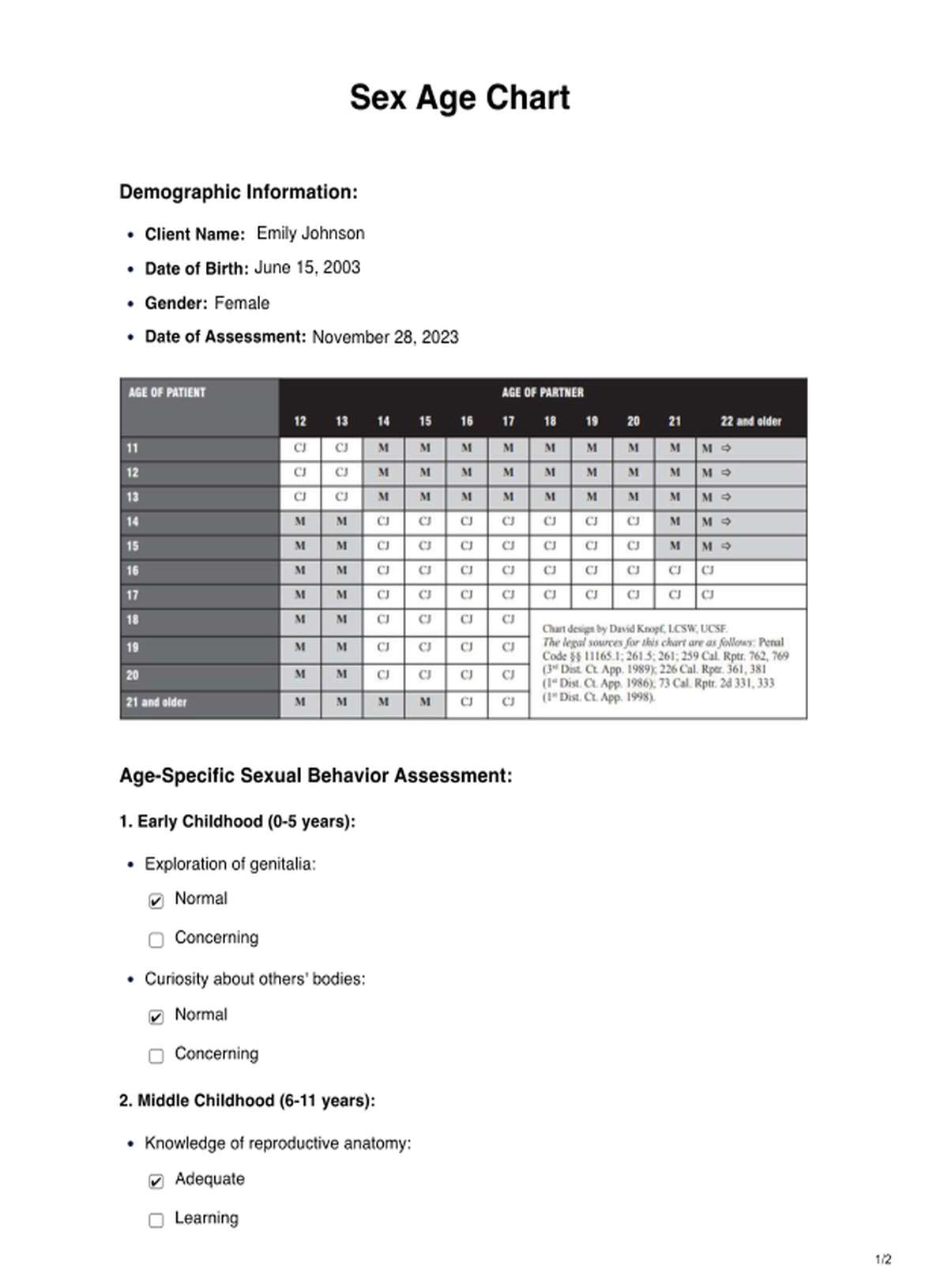Sex Age Chart
Explore comprehensive Sex Age Chart for healthcare insights, analyzing health trends across genders and ages to enhance personalized well-being strategies.


What is a Sex Age Chart?
A Sex Age Chart is a valuable healthcare resource that visually presents data related to health trends across different genders and age groups. Designed to empower healthcare practitioners and Carepatron users, this chart is a dynamic tool for understanding the nuanced intersections of age and sex in various health domains.
This graphical representation lets professionals quickly identify patterns, correlations, and potential risk factors associated with specific demographics. It showcases trends in health outcomes, disease prevalence, and wellness indicators, offering a comprehensive snapshot of how different age groups and genders experience and manage their health.
The Sex Age Chart does not just present raw data; it transforms information into actionable insights. By highlighting disparities and commonalities, healthcare practitioners can tailor their strategies better to address the unique needs of diverse patient populations. A visual guide that facilitates discussions on targeted interventions, preventive measures, and personalized care plans.
In the fast-paced world of healthcare, where precision and efficiency are paramount, the Sex Age Chart emerges as a user-friendly tool. It empowers practitioners to make informed decisions, optimize resource allocation, and ultimately enhance the quality of care provided. As a beacon of clarity in the sea of healthcare data, this resource aligns with Carepatron's commitment to delivering accurate, accessible, and inspiring information to improve patient outcomes and overall well-being.
Sex Age Chart Template
Sex Age Chart Example
How does it work?
The Sex Age Chart serves as a vital tool for healthcare practitioners to assess and understand age-appropriate sexual behavior in their clients. Here is a concise guide on how it works, outlining the steps involved in using and filling out this essential form.
1. Demographic information
Begin by entering the client's full name, date of birth, gender, and assessment date. This foundational information sets the context for the evaluation.
2. Age-specific sexual behavior assessment
Navigate through three developmental stages: Early Childhood (0-5 years), Middle Childhood (6-11 years), and Adolescence (12-17 years). For each stage, assess specific aspects such as genital exploration, reproductive anatomy knowledge, and consent awareness. Mark whether behaviors are deemed normal or concerning, offering a comprehensive view of the client's sexual development.
3. Additional notes and concerns
Use this section to record any additional information or concerns that may arise during the assessment. This ensures a holistic understanding of the client's sexual health beyond the specified categories.
4. Reporting guidelines
The template incorporates critical reporting guidelines, particularly emphasizing situations involving sexual intercourse with a minor. It outlines criteria such as age discrepancies, consent issues, mandatory reporting, and the importance of professional judgment. This section serves as a reminder of legal and ethical obligations.
5. Conclusion
Summarize the assessment findings and note any potential areas of concern. Reinforce the importance of prompt reporting in minor cases, aligning with local laws and regulations.
The Sex Age Chart is designed for easy printing, allowing healthcare practitioners to maintain a tangible record of their client's files. This printable format ensures accessibility and convenience, enabling efficient documentation and sharing of information within healthcare teams.
When would you use this chart?
The Sex Age Chart is an invaluable healthcare resource tailored explicitly for practitioners dealing with sexual health assessments. It finds paramount utility in various contexts, enhancing the precision and depth of patient evaluations.
1. Clinical assessments
Healthcare practitioners, including gynecologists, urologists, and general practitioners, can employ the Sex Age Chart during routine clinical assessments. It provides a structured framework to evaluate age-appropriate sexual behaviors, aiding in identifying potential concerns or deviations from expected developmental norms.
2. Sexual health clinics
Professionals working in sexual health clinics can utilize the chart to assess patients seeking guidance on sexual development comprehensively. By systematically documenting behaviors across different age brackets, clinicians can offer personalized advice, interventions, and education to promote healthy sexual well-being.
3. Pediatric healthcare
Pediatricians can incorporate the Sex Age Chart as a tool to gauge the sexual development of children and adolescents. This is especially crucial in identifying any early signs of developmental concerns or potential red flags that may require further investigation or intervention.
4. Counseling and therapy
Therapists and counselors dealing with sexual health issues can use the chart to facilitate open and informed discussions with clients. It serves as a visual aid, fostering dialogue about age-appropriate behaviors, consent, and any concerns the client may have, contributing to a more holistic approach to mental and sexual health.
5. Legal and ethical compliance
Professionals in legal and ethical advisory roles within healthcare organizations can reference the Sex Age Chart for guidance. This tool includes reporting guidelines ensuring practitioners adhere to legal obligations, especially in situations involving sexual intercourse with minors.
The Sex Age Chart is a versatile tool applicable across diverse healthcare settings. Its structured approach enhances the accuracy of assessments, fosters informed discussions, and ensures practitioners adhere to legal and ethical standards. This resource is instrumental in promoting a holistic understanding of sexual development, aligning to provide patient-centric and ethically sound healthcare services.
What do the results mean?
Interpreting the results of the Sex Age Chart is crucial for healthcare practitioners to make informed decisions about a client's sexual health. While each individual's journey is unique, common results can provide valuable insights into developmental patterns and potential areas of concern.
1. Normal development
If most checkboxes are marked as "Normal" across the three developmental stages, it suggests age-appropriate sexual behavior. This indicates a healthy understanding of one's body, privacy boundaries, and progressive consent awareness. Practitioners can reassure the client and continue monitoring their sexual development over time.
2. Concerning behaviors
If checkboxes in any stage are marked as "Concerning," it signals potential issues that merit closer attention. These may include atypical exploration of genitalia, limited knowledge of reproductive anatomy, or unclear awareness of consent. Healthcare practitioners should engage in further discussions with the client to understand the context and, if necessary, recommend additional assessments or interventions.
3. Reporting concerns
If the form reveals information about sexual intercourse involving a minor, practitioners must adhere to the reporting guidelines outlined in the chart. Age discrepancies, consent issues, and adherence to local laws become critical factors. Reporting such concerns promptly is vital to safeguard the minor's well-being.
Access to a free Sex Age Chart enhances its availability to a broader audience, promoting proactive engagement with sexual health assessments. The chart's user-friendly format and inclusion of reporting guidelines empower practitioners, irrespective of resource constraints, to utilize this valuable tool in their practice.
Research & evidence
The Sex Age Chart, as a tool for assessing age-appropriate sexual behavior, is grounded in a foundation of research and evidence that underscores its significance in healthcare practice.
The chart draws heavily from established principles in developmental psychology, particularly the works of Erik Erikson and Jean Piaget. Erikson's stages of psychosocial development and Piaget's cognitive development theory provide a theoretical framework for understanding age-specific behaviors, including those related to sexual development (Erikson, 1950; Piaget, 1970).
The design of the chart is informed by extensive research on sexual health across different age groups. This includes studies exploring the development of sexual knowledge, attitudes, and behaviors in children and adolescents (Baams et al., 2015; Chandra-Mouli et al., 2015). Such research provides the empirical basis for delineating age-appropriate behaviors.
Incorporating reporting guidelines in the chart aligns with established legal and ethical standards in healthcare. Mandated reporting laws, ethical guidelines from professional organizations, and relevant literature on safeguarding minors contribute to developing these guidelines (Melton et al., 2018; Reamer, 2013).
The chart's design and utility are shaped by feedback from healthcare practitioners, integrating practical insights from professionals actively engaged in sexual health assessments. Regular updates and refinements are made based on the daily experiences and recommendations of those utilizing the chart.
References
Baams, L., Dubas, J. S., Overbeek, G., & van Aken, M. A. (2015). Transitions in body and behavior: A meta-analytic study on the relationship between pubertal development and adolescent sexual behavior. Journal of Adolescent Health, 56(6), 586-598.
Chandra-Mouli, V., Plesons, M., Adebayo, E., Amin, A., Avni, M., Kraft, J. M., ... & Temmerman, M. (2015). Implications of the global early adolescent study’s formative research findings for action and research. Journal of Research on Adolescence, 26(1), 3–13.
Erikson, E. H. (1950). Childhood and Society. New York: Norton.
Melton, G. B., Church, W. T., Conger, R. D., Coulton, C. J., Fure-Slocum, E. M., Irwin, M., ... & Pate, R. R. (2018). Child and adolescent sexual abuse: A review of research over the last decade. Journal of Marriage and Family, 80(1), 7–22.
Piaget, J. (1970). Science of Education and the Psychology of the Child. New York: Orion Press.
Reamer, F. G. (2013). Social work in a digital age: Ethical and risk management challenges. Social Work, 58(2), 163–172.
Commonly asked questions
Practitioners use the Sex Age Chart to document and evaluate behaviors related to sexual development in different age groups. It involves marking checkboxes indicating whether observed behaviors are considered normal or concerning.
Healthcare practitioners, including gynecologists, pediatricians, therapists, and counselors, primarily use the Sex Age Chart. It aids in comprehensive sexual health assessments for individuals across various age brackets.
Depending on the platform or software, some Sex Age Charts may offer customization options to cater to specific healthcare needs. Users can often adapt the chart based on the requirements of their practice.
The Sex Age Chart provides a structured overview of age-appropriate sexual behaviors across developmental stages. It helps practitioners identify normal development and potential concerns, fostering informed decision-making.











































































































